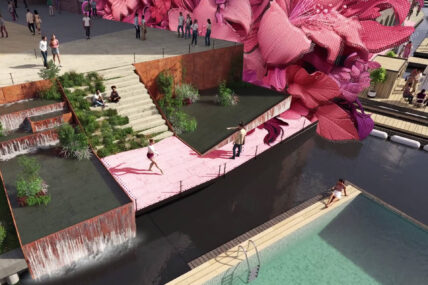The Icon
Alpine-Inspired Modular Pavilion Reimagines Temporary Installations
Minimal ecological impact
Situated in Davos, Switzerland, for the 2025 World Economic Forum, The Icon, designed by Skreinstudios, seeks to redefine the concept of temporary architectural installations in both urban and natural landscapes. Its distinctive circular form, constructed from locally sourced Swiss timber, is intended to disappear and reappear with minimal ecological impact.
The pavilion is arranged in flat, linear wooden panels wrapped around a curved façade—a deliberate rejection of the tech-forward aesthetic that often dominates Forum installations. The untreated wooden shingles, as shown in the architectural renderings, will age naturally over time, forming a protective patina—even as the structure itself moves between locations.
Demountable design
What also distinguishes this 180-square-meter modular structure from typical buildings is its mobility and modularity—a physical manifestation of contemporary ideas about regenerative space. Inside, the pavilion is organized around a series of rooms, each designed for varying scales of discourse, from private discussions to larger group meetings.
Its modular design not only allows for rapid assembly and disassembly but also positions it as a replicable architectural typology. The project is a scalable template for future spaces where architecture becomes a catalyst for conversations about climate resilience and the evolving relationship between built and natural environments.
Otherworldly atmosphere
To effectively communicate the Icon, we designed each shingle as a distinct geometry, reflecting the layered structure of the façade—a process that required heightened attention to material texture and light behavior. Then each tile was individually crafted to achieve accurate texture and deliberate irregularities, enhancing the realism of the surface.
In the final renderings, the lighting strategy became a focal point so we conducted multiple tests to assess the optimal placement of LED lights, creating a subtle, cinematic glow throughout the images. The project also requires scenes depicting a specific demographic—a well-dressed, elite audience—a detail that subtly informs our visual narrative. Typically, this focus on people involved an intensive search for 3D assets, but with AI, we could more effectively convey the desired sophistication.
Throughout our collaboration, the pavilion’s context, initially described as nestled in a dense forest, evolved into a more open, residential setting with another building in proximity. Adjusting the visuals and animations to reflect the actual site became an exercise in balancing the imagined with the real, a dynamic that shaped the final series of images.
Project details
Location
Davos, Switzerland
Partner
Team
Emilija Morica
Bence Falussy
